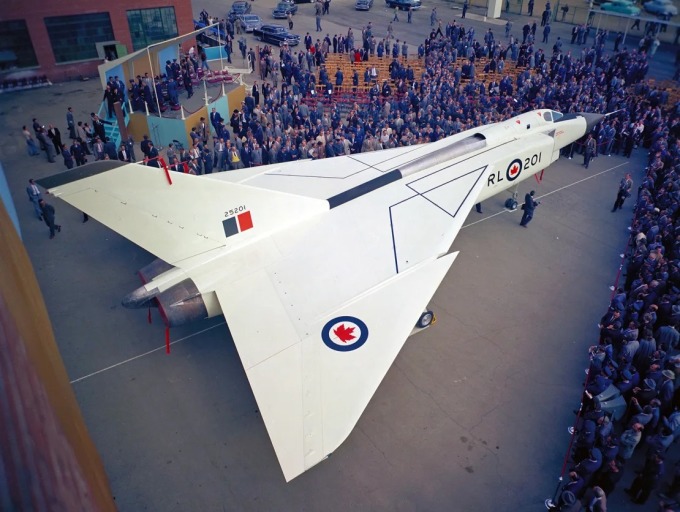
The Avro Arrow, once envisioned as Canada’s crowning aviation achievement, quickly became a source of regret and controversy after its abrupt cancellation.
When planning the development of the supersonic bomber Avro Arrow, also known as the CF-105, Canada hoped it would neutralize the threat of Soviet nuclear bombers and position the country as a global leader in aviation technology and military aerospace.
Canadian officials placed great expectations on the Avro Arrow. However, the dream turned into a nightmare when the program was canceled in 1959, less than a year after its maiden flight.
Sixty-five years later, the Avro Arrow remains one of Canada’s greatest missed opportunities and a topic of public debate, as newly declassified documents shed light on the project’s fate.
“This was a fully Canadian-built aircraft, and its performance indicators during development suggested it was at least on par with the most advanced designs of its time,” said Richard Mayne, a historian with the Royal Canadian Air Force. “When it was canceled, many questions arose. Even now, the Avro Arrow occupies a significant place in the public’s imagination.”
The Avro Arrow project was Canada’s direct response to the threat posed by Soviet bombers capable of delivering nuclear payloads over the Arctic to North America during the post-World War II era.
“In 1952, the Royal Canadian Air Force requested the development of an interceptor capable of reaching Mach 2 (twice the speed of sound) and altitudes above 15,200 meters,” Mayne explained. “They needed something fast, with sufficient range and altitude to intercept Soviet bombers as far north as possible, before they reached Canada.”
Avro Canada, the aircraft manufacturer behind the successful CF-100 Canuck fighter jet, was immediately tasked with creating a far more powerful version.
This ambitious plan came at a pivotal time for Canada. “Canada emerged from World War II as a key participant. We had the world’s third-largest navy and fourth-largest air force. However, Canadian citizenship wasn’t formally established until 1947. We were still a very young nation,” Mayne noted.
Development of the Avro Arrow began in 1955, and in record time, the first aircraft debuted to the public on October 4, 1957—the same day the Soviet Union launched Sputnik I, the world’s first artificial satellite, marking the dawn of the space age.
“It was an unfortunate coincidence,” Mayne explained. “Sputnik demonstrated that nuclear warheads could be delivered via missiles into orbit. The Arrow was powerless against intercontinental ballistic missiles (ICBMs).”
The Avro Arrow, designed for a two-person crew and featuring elegant white delta wings, measured approximately 23 meters in length with a 15-meter wingspan. It first flew on March 25, 1958. However, by then, Canadian strategists, military leaders, and politicians believed the world had entered an era of "push-button warfare," where the nuclear threat was confined to long-range missiles, rendering interceptors and bombers less relevant.
“This turned out to be a misjudgment, as the threat from bombers persists even today,” Mayne noted. “But at the time, that was the prevailing view.”
Against this backdrop, the Avro Arrow lost its perceived strategic relevance. Additionally, escalating costs and shifting political priorities left Canada with little incentive to pursue its aerospace dream.
On February 29, 1959, Canadian Prime Minister John Diefenbaker canceled the program. Weeks later, Canada destroyed five completed aircraft and most of the assembly lines, fearing they might become targets for Soviet espionage. The decision led to the collapse of Avro Canada and left thousands unemployed.
“If the UK had agreed to purchase a few Arrows, it might have saved the program,” Mayne said. “But without foreign contracts, Canada was too small to sustain such an advanced technology. We aimed too high. Ironically, many Avro engineers later joined NASA and contributed to the Apollo program.”
Rumors and conspiracy theories about the abrupt cancellation emerged almost immediately, some persisting to this day.
“The Arrow has almost achieved mythical status in Canada,” said Alan Barnes, a senior fellow at Carleton University in Ottawa.
One popular theory suggests that the U.S. misled Canada about a shifting Soviet threat to prevent Canada from producing a superior aircraft. Another posits that Canadian intelligence analysts fabricated this narrative to justify the government’s decision.
“All of this is speculation,” Barnes explained, “because no one has thoroughly reviewed the intelligence reports.”
In 2023, Barnes published an article after examining archival documents that highlighted the connection between intelligence assessments and their use by decision-makers at the time.
“Initially, the air force wasn’t focused on intelligence,” Barnes said. “They wanted a grand, cutting-edge aircraft and issued operational requirements without consulting intelligence reports.”
By the late 1950s, however, the Arrow project had become a financial drain. In early 1958, Canadian intelligence assessed that the bomber threat was less severe than previously thought, as the Soviet Union was shifting its focus to missile production.
This led to the conclusion that there was little justification for spending heavily on an aircraft incapable of addressing the ICBM threat.
By the summer of 1958, the Canadian Chiefs of Staff decided not to recommend continuing the program but delayed a formal cancellation to avoid political fallout. The decision ultimately cost the government political capital, contributing to its electoral defeat a few years later.
According to Barnes, the Avro Arrow never lived up to its perceived potential. The project was terminated prematurely, and the public’s inability to see the aircraft in action fueled myths about its supposed superiority.
“It never flew with weapons or the engines it was designed for. Everything was hypothetical, leading many Canadians to believe it could have been the best aircraft in the world,” Barnes emphasized.
In 1997, Canada’s CBC network commissioned a drama about the Arrow. A full-scale wooden model built for the production is now stored at the Reynolds Museum in Wetaskiwin, Alberta.
Another aluminum model is displayed at Edenvale Airport near Muskoka, Ontario. A third, two-thirds the original size, is being built at Springbank Airport in Calgary and is expected to be flight-capable by 2026.
Although no complete Avro Arrows remain, the original cockpit, nose section, and wings are exhibited at the Canada Aviation and Space Museum in Ottawa.
Canada’s enduring fascination with the Avro Arrow was evident in 2018 when submerged test models from the 1950s were recovered from Lake Ontario. Previous search efforts had failed, but Canadian businessman John Burzynski funded the successful expedition.
“Recovering these models serves as a reminder of Canada’s tremendous effort to design, test, and build an advanced aircraft in just six years,” Burzynski said. “The Arrow program demonstrates that anything is achievable with enough ingenuity and determination.”
Hello Shuttle will strive to bring the latest updates. At the end of the day.
Are you looking for reliable airport and cruise port transfer services in Los Angeles?
We offer professional, safe, and punctual transportation from
Los Angeles Airport - LAX
Long Beach Airport - LGB
John Wayne Airport - SNA
San Pedro cruise port
Long Beach cruise port
Disneyland
and other destinations.
Let us make your journey stress-free and comfortable with our dedicated drivers and high-quality vehicles. Book now for the perfect travel experience at www.helloshuttle.com or call 944-800-5678!


